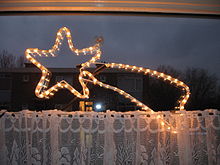Fairy lights (lighting)

A chain of lights consists of several light sources on a common carrier.
Design
Fairy lights used to be operated with mains voltage (e.g. 230 V); For safety reasons, they are available today with a power supply unit and low voltage (e.g. 24 V). In the European Union, fairy lights that are suitable for outdoor use must meet a corresponding protection class , e.g. B. IP 44 , represented by this string or the symbol of a water drop in a triangle.
So that with chains of incandescent lamps operated in series , when a lamp burns out, the entire lighting does not fail and the defective lamp can be located, there is a varistor in each incandescent lamp as a current bridge , which ensures the flow of current even when the filament is interrupted. However, defective light bulbs should be replaced as soon as possible, as the voltage on the others increases as a result of the failure, which reduces their service life and leads to excessive heating (risk of fire).
Traditional fairy lights, which are used for Christmas, often have light bulbs in the form of candles and are attached to the branches of a Christmas tree instead of candles , for which purpose appropriate clips are attached to the sockets. With many fairy lights, one end of the cable can be detached from the plug, which makes it easier to attach the fairy lights to the tree. In addition to chains of lights with pears or sockets in the shape of candles , chains were also made for use on the Christmas tree in the past . B. had nuts, angel figures or balls. A more modern variant are appropriately shaped plastic bodies that are plugged onto the lightbulbs. Fairy lights with a flashing function are also available.
Precisely because more and more attention is paid to energy efficiency , more and more fairy lights with light-emitting diodes are emerging . They have a much lower power consumption (up to 80% less than incandescent lamps). Furthermore, the lower power loss and the associated heating of the light-emitting diodes also reduce the risk of fire. There is a wide range of colors, and some suppliers already offer “warm white” light-emitting diodes.
Pollutants
In 2019, the Federation for the Environment and Nature Conservation Germany tested four fairy lights in a random sample. The phthalates DEHP and DBP massively exceeded the limit values of the RoHS guidelines for three of the four products. The same three products have also exceeded the limit value according to the EU POP regulation for SCCP .
See also
literature
- E. Rhein: You and the electricity . Berlin, Ullstein 1940. p. 314 ff, a candle goes out .
- Jelena Nagel, Günter Ott, Erik Romanus, Hans-Jörg Windberg, Susanne Woelk: Dangerous household and leisure products: kettles and toasters, felt pens, laser pointers, fairy lights, multiple sockets and socket strips . Hamburg: The Safe House, German Board of Trustees for Safety in Home and Leisure (DSH) - Dortmund: Federal Institute for Occupational Safety and Health. 2017.
Web links
Individual evidence
- ↑ Identification of fairy lights / light nets
- ↑ Christmas lights: BUND detects high levels of illegal pollutants in fairy lights. BUND, November 19, 2019, accessed December 11, 2019 .
